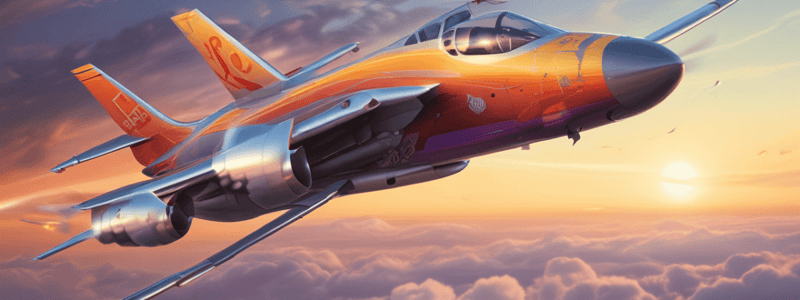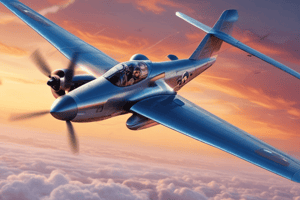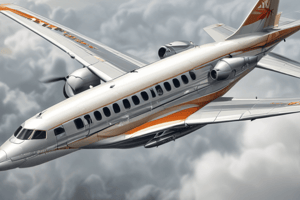Podcast
Questions and Answers
What is a major advantage of elliptical wings over other wing shapes?
What is a major advantage of elliptical wings over other wing shapes?
- Improved lift distribution over the span of the wing (correct)
- Increased structural strength
- Reduced induced drag
- Simpler manufacturing process
Which type of wing is most prone to induced drag?
Which type of wing is most prone to induced drag?
- Rectangular wings (correct)
- Elliptical wings
- Tapered wings
- Swept wings
What is a common issue with rectangular wings in terms of lift distribution?
What is a common issue with rectangular wings in terms of lift distribution?
- It is constant over the span of the wing
- It is greater near the root and decreasing towards the tip (correct)
- It is greater near the tip and decreasing towards the root
- It is symmetrical over the span of the wing
What is the primary advantage of tapered wings over rectangular wings?
What is the primary advantage of tapered wings over rectangular wings?
According to the content, what is the key to designing wings that optimize an aircraft's performance?
According to the content, what is the key to designing wings that optimize an aircraft's performance?
What is the main compromise that tapered wings offer?
What is the main compromise that tapered wings offer?
Why are tapered wings common in commercial and military aircraft?
Why are tapered wings common in commercial and military aircraft?
What is the primary disadvantage of elliptical wings?
What is the primary disadvantage of elliptical wings?
What is a benefit of tapered wings compared to elliptical wings?
What is a benefit of tapered wings compared to elliptical wings?
What is the primary consideration when selecting a wing design?
What is the primary consideration when selecting a wing design?
Tapered wings have a more optimal lift distribution compared to elliptical wings.
Tapered wings have a more optimal lift distribution compared to elliptical wings.
Rectangular wings are the most efficient wing shape at higher angles of attack.
Rectangular wings are the most efficient wing shape at higher angles of attack.
Tapered wings are used exclusively in commercial aircraft due to their simplicity.
Tapered wings are used exclusively in commercial aircraft due to their simplicity.
Elliptical wings are the most common wing shape in aircraft design.
Elliptical wings are the most common wing shape in aircraft design.
Rectangular wings have a better lift distribution than tapered wings.
Rectangular wings have a better lift distribution than tapered wings.
The primary consideration when selecting a wing design is the cost of production.
The primary consideration when selecting a wing design is the cost of production.
Tapered wings are less efficient than rectangular wings.
Tapered wings are less efficient than rectangular wings.
Elliptical wings are simpler to construct than tapered wings.
Elliptical wings are simpler to construct than tapered wings.
The main advantage of rectangular wings is their high efficiency.
The main advantage of rectangular wings is their high efficiency.
Tapered wings are used in aircraft that require high maneuverability.
Tapered wings are used in aircraft that require high maneuverability.
What is the primary drawback of rectangular wings that affects their overall efficiency?
What is the primary drawback of rectangular wings that affects their overall efficiency?
How do the aerodynamic properties of tapered wings compare to those of elliptical wings?
How do the aerodynamic properties of tapered wings compare to those of elliptical wings?
What is the primary advantage of tapered wings in terms of their structural and manufacturing characteristics?
What is the primary advantage of tapered wings in terms of their structural and manufacturing characteristics?
What is the primary effect of induced drag on an aircraft's performance?
What is the primary effect of induced drag on an aircraft's performance?
What is the primary factor that determines the suitability of a particular wing design for an aircraft?
What is the primary factor that determines the suitability of a particular wing design for an aircraft?
How does the lift distribution of a rectangular wing compare to that of a tapered wing?
How does the lift distribution of a rectangular wing compare to that of a tapered wing?
What is the primary benefit of elliptical wings in terms of their aerodynamic properties?
What is the primary benefit of elliptical wings in terms of their aerodynamic properties?
What is the primary trade-off between the aerodynamic properties and structural and manufacturing characteristics of wing designs?
What is the primary trade-off between the aerodynamic properties and structural and manufacturing characteristics of wing designs?
How do the performance requirements of an aircraft affect the selection of a wing design?
How do the performance requirements of an aircraft affect the selection of a wing design?
What is the primary benefit of understanding the efficiencies and limitations of different wing designs?
What is the primary benefit of understanding the efficiencies and limitations of different wing designs?
Flashcards are hidden until you start studying
Study Notes
Wing Designs in Aviation
- Wing design is a critical factor in aircraft performance, influencing efficiency in flight and an aircraft's capability to meet its designed purpose.
- Each wing design has its own unique characteristics, implications, and purposes.
Rectangular Wings
- Simplest form of wing design
- Often found on basic training aircraft and light aircraft
- Equal chord distribution makes for forgiving stall characteristics and consistent behavior
- Not the most efficient for high-speed travel due to increased drag
- Manufacturing simplicity makes them a solid choice for cost-effective, low-speed aircraft
Elliptical Wings
- Hailed for their aerodynamic perfection
- Distribute lift evenly across the span, minimizing induced drag
- Historically found on swift fighters like the Supermarine Spitfire, optimizing maneuverability and speed
- Complexity makes them a challenge to manufacture
- Pristine aerodynamic benefits can outweigh manufacturing difficulties, especially when performance is paramount
Tapered Wings
- Represent a compromise between rectangular and elliptical shapes
- Tapering allows for reduced drag while maintaining respectable stall behavior
- Often seen on general aviation aircraft
- Provide a good balance between performance and practicality
- Do not perfectly match the efficiency of elliptical wings but are much easier to produce
Aerodynamic Characteristics of Wings
- Every wing is subject to the same basic aerodynamic forces: lift, drag, weight, and thrust
- Lift generation, stall response, and fuel efficiency are factors influenced by wing design
- Recognizing wing designs instantly connects us to their inherent flight characteristics
Importance of Wing Design
- The shape of an aircraft's wing can greatly affect how it flies, how it creates lift, and how it handles at various speeds and altitudes
- Understanding the efficiencies and limitations of different wing designs is key to designing wings that optimize an aircraft's performance for its intended use
Foundations of Flight: Wing Designs
- Wing design is a critical factor in aircraft performance, influencing efficiency and capability.
- Different wing shapes have unique characteristics, advantages, and limitations.
Rectangular Wings
- Simplest form of wing design
- Found on basic or low-speed aircraft, such as training aircraft
- Characterized by straight leading and trailing edges and a constant chord from root to tip
- Easier and more economical to construct, repair, and maintain
- Create more induced drag compared to other wing shapes
- Lift distribution is not optimal, with greater lift near the root and decreasing towards the tip
Elliptical Wings
- Often celebrated for aerodynamic efficiency
- Characterized by a smooth, oval-shaped planform that minimizes induced drag
- Distributes lift evenly across the entire span, resulting in uniform lift distribution
- Famous example: Supermarine Spitfire
- Not commonly used in modern aviation due to complexity and high production costs
Tapered Wings
- Offer a compromise between elliptical and rectangular wings
- Gradually narrow or taper from root to tip, reducing wing area towards the wingtips
- Help reduce induced drag and improve lift distribution over the span of the wing
- Common in commercial and military aircraft due to balance between performance and practicality
- Provide a good middle ground with better aerodynamic properties than rectangular wings and simpler construction than elliptical wings
Wing Design Considerations
- Engineers must consider mission profile and performance requirements of the aircraft
- Ultimate choice of wing design depends on factors such as cost, manufacturing capabilities, structural considerations, and specific performance objectives
- Understanding efficiencies and limitations is key to designing wings that optimize an aircraft's performance for its intended use
Wing Shapes and Aerodynamics
- Wing design plays a critical role in aircraft performance, influencing efficiency in flight and capability to meet its designed purpose.
Elliptical Wings
- Elliptical wings are characterized by their smooth, oval-shaped planform, which minimizes induced drag.
- They distribute lift evenly across the entire span, resulting in a more uniform lift distribution.
- Elliptical wings are ideal for high-speed aircraft, but their complexity and high manufacturing cost limit their use.
Rectangular Wings
- Rectangular wings are the simplest form of wing design and are often found on basic or low-speed aircraft.
- They have a constant chord from root to tip, making them easier and more economical to construct, repair, and maintain.
- However, rectangular wings create more induced drag compared to other wing shapes, reducing the aircraft's overall efficiency.
Tapered Wings
- Tapered wings offer a compromise between the aerodynamic efficiency of elliptical wings and the structural and manufacturing simplicity of rectangular wings.
- They gradually narrow or taper from root to tip, reducing the wing area toward the wingtips.
- Tapered wings are common in both commercial and military aircraft due to their balance between performance and practicality.
Wing Design Considerations
- When selecting a wing design, engineers must consider the mission profile and performance requirements of the aircraft.
- The ultimate choice of wing design depends on factors such as cost, manufacturing capabilities, structural considerations, and specific performance objectives.
- Understanding the efficiencies and limitations of different wing designs is key to designing wings that optimize an aircraft's performance for its intended use.
Studying That Suits You
Use AI to generate personalized quizzes and flashcards to suit your learning preferences.




